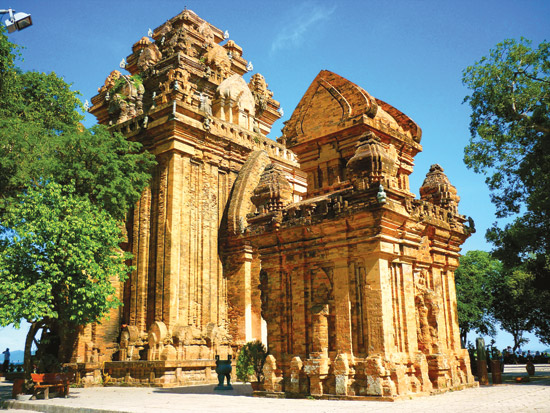(No.8, Vol.3, Sep 2013 Vietnam Heritage Magazine)
Ponaga towers in Nha Trang. Photo: Huynh Van Nam.
Going from Binh Thuan up to Danang, my impression was of the pristine, alluring seacoast, a place where the sands, ocean waves, and the sun intermingle. From Nha Trang turning out towards the north begin mountains and mountain passes. The mountains stretch out to the sea, the mountain passes succeed one another, and the delta plains are interspersed with river rapids, thereby creating meandering paths through imposing, spectacular mountain passes. On one side are tottering mountains, while the other side looks out to the deep sea along with long moors of parched sand, dreamlike bays, and expansive estuaries that pour out into the deep blue ocean. Going downstream to the delta, one intermittently espies tower temple structures that appear in dilapidated ruin, yet retain something lofty, noble, and full of mystery.

Carved details on a tower at Banh It tower group in Binh Dinh Province, South-Central Vietnam. Photo: Le Huu Truc.
They may not be as densely concentrated or sophisticated as in the sacred lands of My Son, but the vestigial remains of Champa that lie scattered the South-Central coast still retain, relatively intact, the original figure and appearance of the architectural features and primitive, yet exquisite carvings. Majestic, yet desolate; lofty, but melancholy — the temples exude an allure of phantasmal beauty that radiates with energy. Beneath the golden sunlight of Central Vietnam, the thousand-year-old temples remain a brilliant red, taut with profuse vitality, and extend forcefully beneath the windy blue sky. Between heaven and earth, amidst the vastness of the sun and moon, and accompanied by the murmur of the winds, the tower temples stand, lined up as if to promise and yearn together. They absorb and store a vitality that is the image of the preservation and conversion of the energy of a place that converges between the earth and sky.

A Cham tower temple in Phan Rang, Ninh Thuan South-Central Province, 2010. Photo: Hoang Quoc Tuan.
The tower temples live in harmony with life, having chosen to rest at the most elevated positions in the lands on which they sit, amidst unassuming villages in a place where a quiet life effuses through the humble peasants. In contrast to the sacred lands of My Son in Quang Nam Province of South-Central Vietnam, the cluster of tower temples here seem to dwindle in religiosity in a way that adds to their quality of life and, ultimately, manifests an immaculate beauty amidst ordinary life. Here, art and life merge. The temples link heaven and earth, holding back space and time. Thus, the dawn here comes late, and the hushed twilight lingers long. Time goes on to tightly envelope the feet of the tower temples, gradually fastening around the circle of temples in each and every Cham brick and shattered sandstone shard. Time seems purified through each and every Cham brick furrow and sculptural feature.

Cham temples in Ninh Thuan South-Central Province. Photo: Pham Thi Kim Thanh
The reliefs, stone statues, and altars are exquisitely engraved. The lingams and yonis are replete with vitality. The carved Aspara dancers and their enlightened Cham smiles, transcendent beyond time, breathe from their stone faces. Everything manifests the utmost religious fervour and fanaticism in an eerie space steeped in the mystifying hues of sunlight. The carvings are subtle and replete with emotions. They reflect a boundless faith while conveying the dreams and yearnings of so many generations of Cham people. Who knows whether the ancient artists carved directly into raw or baked bricks? Nevertheless, because of the exceedingly sweet engravings on the material and the warm, intimate sensation we get from the baked clay whenever we touch them with our hands, the carvings convey the confidence over thousands of years in the abidingness of a material that is not everlasting, bricks; yet eternal, the earth.
The art here possesses an evocative power that goes beyond all boundaries of culture and beliefs. Inside the bowels of the temple, the towers are empty and full of shadows, but at the top of the temple, a doorway always opens straight out into the blue sky. Through this doorway, the tower temples intersect with the blue sky and receive the day’s sunlight. The bright sunlight loses its way inside and scatters askance through the levels of the temple, combining with the wind to create a sense of secluded wandering and mystery. Add to that a bit of fissure and fragmentation and a touch of ruin, and the Cham temples become even more visionary and illusory. Everything amounts to an incorruptible beauty, a beauty that is entirely Cham.
Behind art there is always a cultural foundation, a human realm that is real and full of life. Cham culture still seems to endure there. The sacred fires continue to burn, smouldering in the bowels of the tower temples. They are the fires of religious belief, a belief in resurrection, the resurrection of a thirst to harmonize with the universe. They are the fires of architecture, intermingling sculpture, Cham music, and Cham song and dance. All of this contributes to leaving a memory of the Cham and retaining for them the mysterious beauty of the Cham tower temples, a beauty that causes people to behold space and time.

Carved details at Po Nagar tower temple, Nha Trang

An Apsara dancer at Posahinu temple, Binh Thuan South-Central Province.
Photo: Ngo Dinh Hoa

Thap Doi, a Cham tower temple in Binh Dinh Province, South-Central Vietnam

Chien Dan tower temples in Quang Nam South-Central Province. Photos: Nguyen Ba Ngoc

